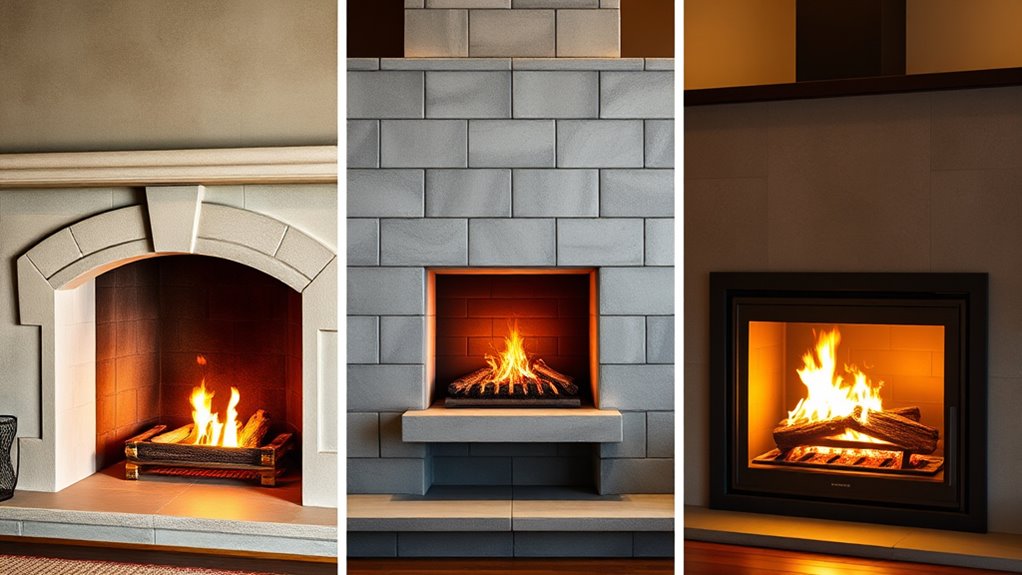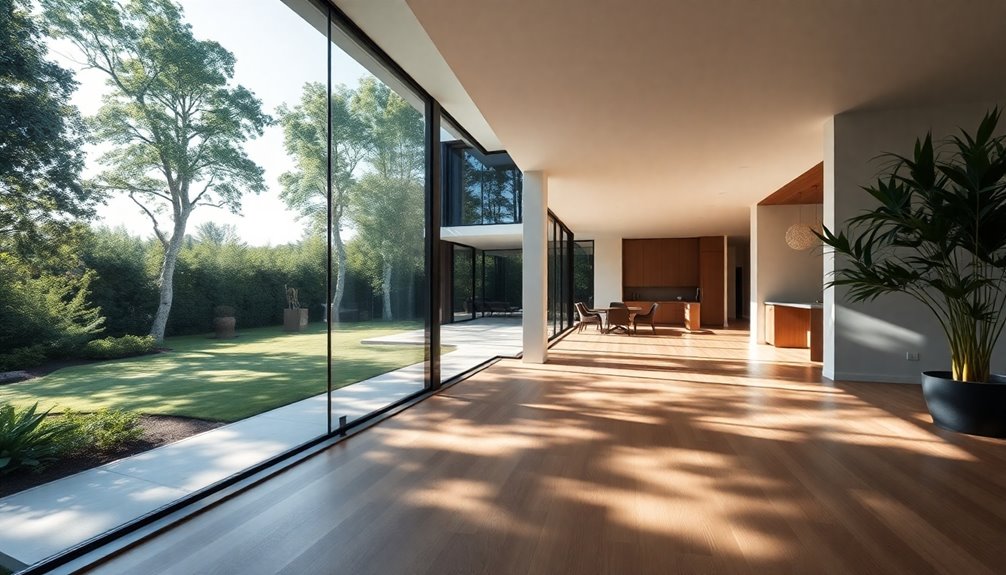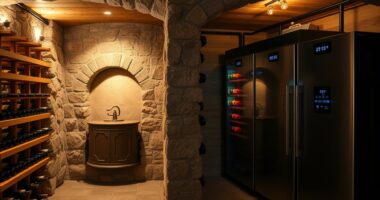When comparing fireplaces, Rumford features a traditional tall, narrow opening with excellent airflow and heat projection, ideal for historic styles. Isokern uses modular ceramic components with high insulation, offering modern efficiency and flexible design. Direct-vent models provide sealed, high-performance systems with up to 80% efficiency and sleek aesthetics suited for contemporary homes. Understanding these differences helps you choose the best system for your style and heating needs—continue exploring to discover which option fits your project best.
Key Takeaways
- Rumford fireplaces feature traditional masonry designs with tall, narrow openings that promote airflow and heat transfer.
- Isokern fireplaces use modular ceramic components for efficient insulation, quick installation, and a modern aesthetic.
- Direct-vent systems are sealed units with glass fronts, offering high efficiency (up to 80%) and outside air combustion.
- Rumford fireplaces suit historic or classic homes, while Isokern and Direct-vent offer more modern, customizable styles.
- Installation ease varies: Rumford requires custom chimney work; Isokern and Direct-vent provide flexible, low-maintenance options.

Have you ever wondered how a fireplace can transform your living space into a cozy retreat while serving as a functional heating source? When considering different types, understanding the core differences between Rumford, Isokern, and direct-vent fireplaces helps you make an informed choice tailored to your needs. Each design offers distinct advantages rooted in construction, efficiency, and aesthetic appeal, so recognizing their technical features is essential.
Rumford fireplaces, developed in the 18th century, are renowned for their innovative design aimed at maximizing heat efficiency and reducing smoke. Characterized by a tall, narrow opening with a deep firebox and a tapered throat, they promote better airflow and complete combustion. This setup directs more heat into your room rather than up the chimney, which means improved energy efficiency. The tall profile also helps with heat retention as it allows the hot gases to rise rapidly, pushing smoke upward and out efficiently. Constructed with thick masonry or firebrick, Rumford fireplaces are highly durable and weathered for decades, but they often require a custom-built chimney system due to their unique proportions. Their aesthetic, rooted in classic architecture, lends a timeless appeal, making them suitable for historic or traditional homes.
Rumford fireplaces feature tall, narrow openings, promoting efficient heat flow and classic architectural elegance.
Isokern fireplaces leverage modern manufacturing techniques, combining ceramic fireboxes with modular masonry components. They are engineered for rapid installation and superior efficiency. The key feature here is the insulated, ceramic firebox, which minimizes heat loss and enhances combustion efficiency. These units are designed to withstand high temperatures and provide a clean, controlled burn, reducing creosote buildup and emissions. The modular design allows for customization of appearance and size, providing flexibility without sacrificing performance. Isokern systems are often paired with high-efficiency chimneys, ensuring compliance with modern building codes and environmental standards. Their sleek, contemporary look appeals to those seeking a blend of traditional charm with modern performance, and their precise engineering results in consistent heat output, making them ideal for energy-conscious households.
Direct-vent fireplaces are a fully sealed system, drawing combustion air directly from outside and exhausting gases outside through a dedicated venting system. This configuration offers exceptional safety and efficiency, as it isolates indoor air from combustion byproducts. The sealed design also enables flexible installation options, including zero-clearance setups that fit into tight spaces or retrofit existing fireplaces. These units typically feature glass fronts that allow viewing of the fire while preventing heat loss and drafts. They operate with high efficiency—up to 80%—and produce consistent, controllable heat output. Because they don’t rely on indoor air for combustion, they preserve indoor air quality and eliminate drafts, making them especially suitable for modern, energy-efficient homes. Their sleek, minimalist aesthetics and ease of installation make them a popular choice for contemporary interiors, merging functionality with style.
Frequently Asked Questions
Which Fireplace Type Is Most Energy-Efficient?
You’ll find that direct-vent fireplaces are the most energy-efficient because they seal combustion gases inside, preventing heat loss and reducing drafts. They use outside air for combustion, which conserves indoor air quality and minimizes heat escape. Rumford and Isokern fireplaces can be efficient too, but their designs typically allow more heat to escape. For maximum energy savings, opt for a high-efficiency direct-vent model with sealed combustion.
How Long Does Installation Typically Take?
If you’re installing a direct-vent fireplace, expect it to take about one to three days. For example, a homeowner in a recent project completed the installation in two days by coordinating with licensed professionals. The process involves framing, venting, and finishing work, which varies based on your home’s complexity and local building codes. Proper planning and experienced installers can help prevent delays and ensure a smooth, efficient setup.
Are These Fireplaces Suitable for Small Spaces?
Yes, these fireplaces are suitable for small spaces. Rumford and Isokern models are specifically designed with compact dimensions, allowing efficient heating without overwhelming the room. Direct-vent units are also space-efficient, venting directly through an exterior wall, eliminating the need for a chimney. Their modern, sleek design maximizes space while providing effective heat and aesthetic appeal. Proper installation guarantees safety and ideal performance in limited areas, making them excellent choices.
What Are the Maintenance Requirements for Each?
You’ll find that Rumford fireplaces require regular chimney cleaning and ash removal to maintain efficiency. Isokern units demand minimal upkeep, with occasional inspection of the firebox and glass for soot buildup. Direct-vent fireplaces need annual professional inspections to ensure proper venting and safety. Although maintenance varies, selecting a fireplace with accessible components facilitates upkeep, ensuring your investment remains safe, efficient, and hassle-free over time.
Can These Fireplaces Be Used With Existing Chimneys?
Yes, you can typically use these fireplaces with existing chimneys, but it depends on your chimney’s condition and compatibility. Rumford fireplaces often require chimney lining upgrades for efficiency, Isokern units may need custom adaptations, and direct-vent models usually don’t need a chimney at all. To guarantee safety and ideal function, have a professional inspect your chimney system and confirm it meets the specific requirements for your chosen fireplace type.
Conclusion
Choosing between Rumford, Isokern, and direct-vent fireplaces depends on your heating needs and aesthetic preferences. Did you know that direct-vent systems can be up to 80% efficient, conserving energy while providing cozy warmth? By understanding each design’s technical advantages—like Rumford’s efficient airflow or Isokern’s customizability—you can make an informed decision that enhances both comfort and cost savings. Invest wisely in your fireplace; it’s a centerpiece that combines function, efficiency, and style.








